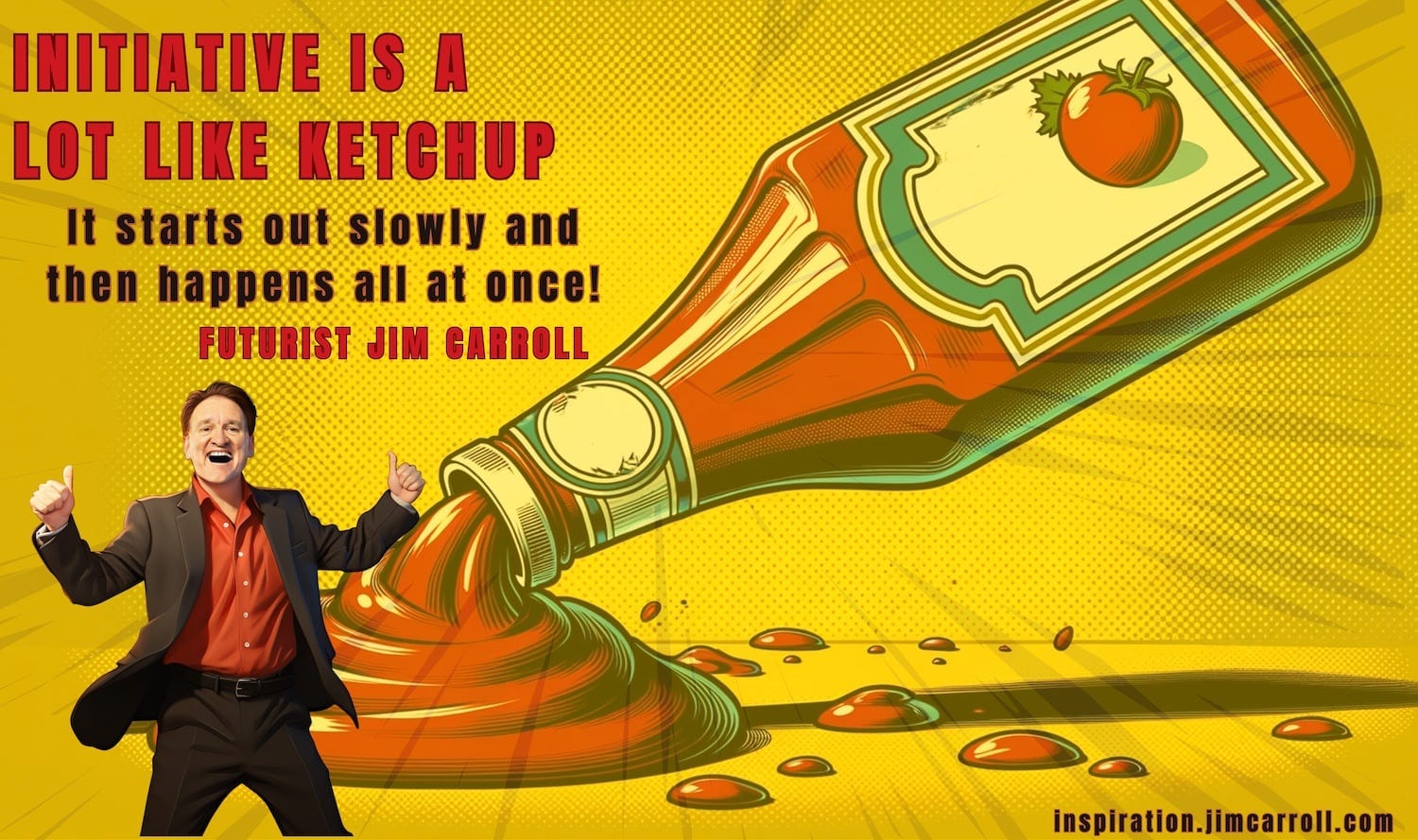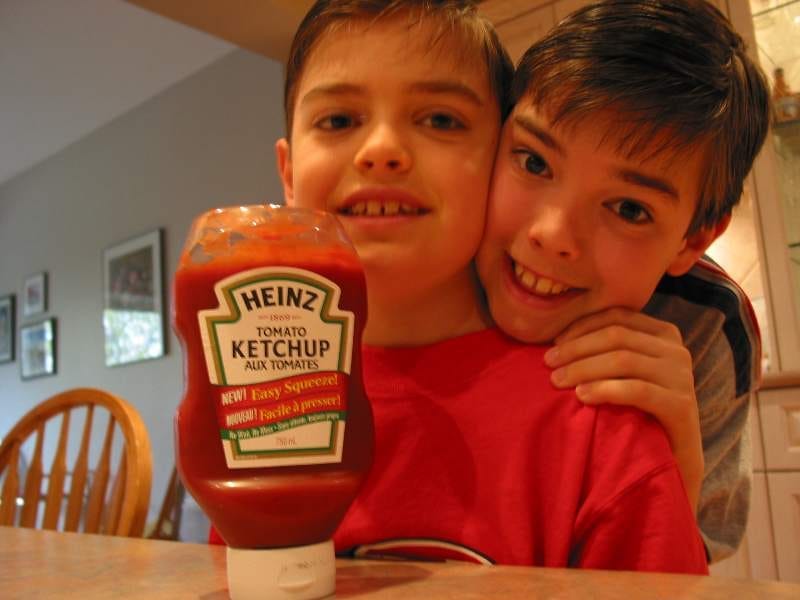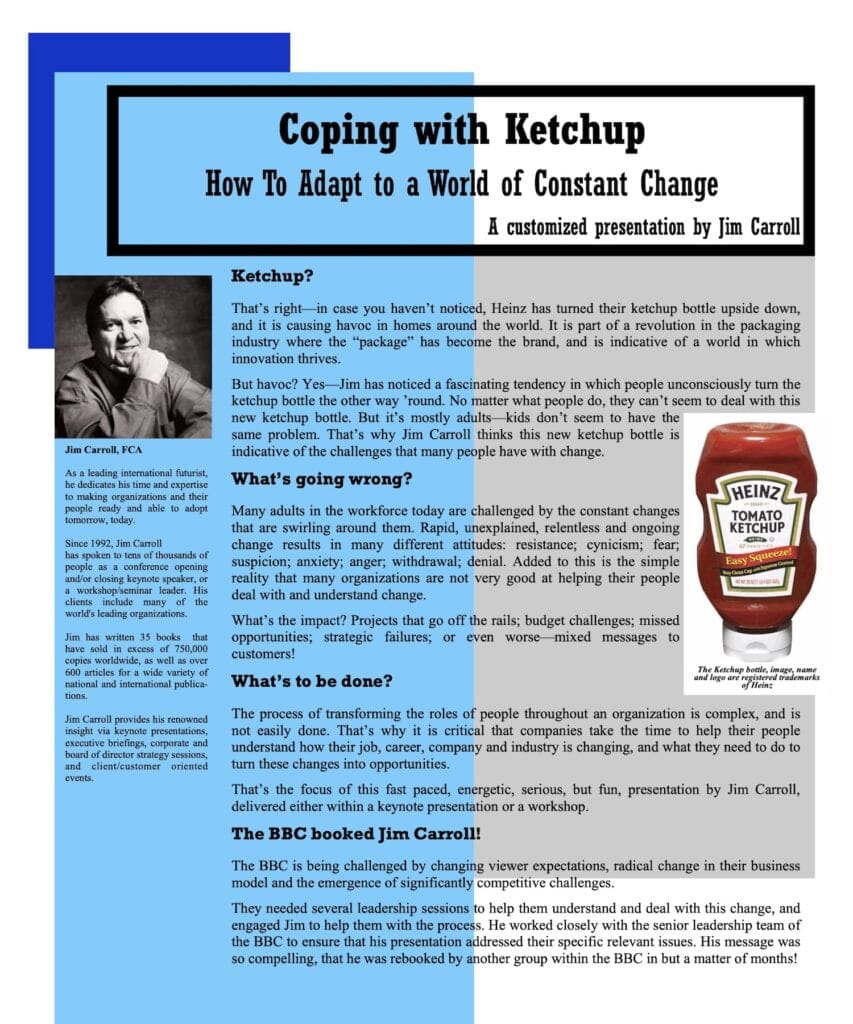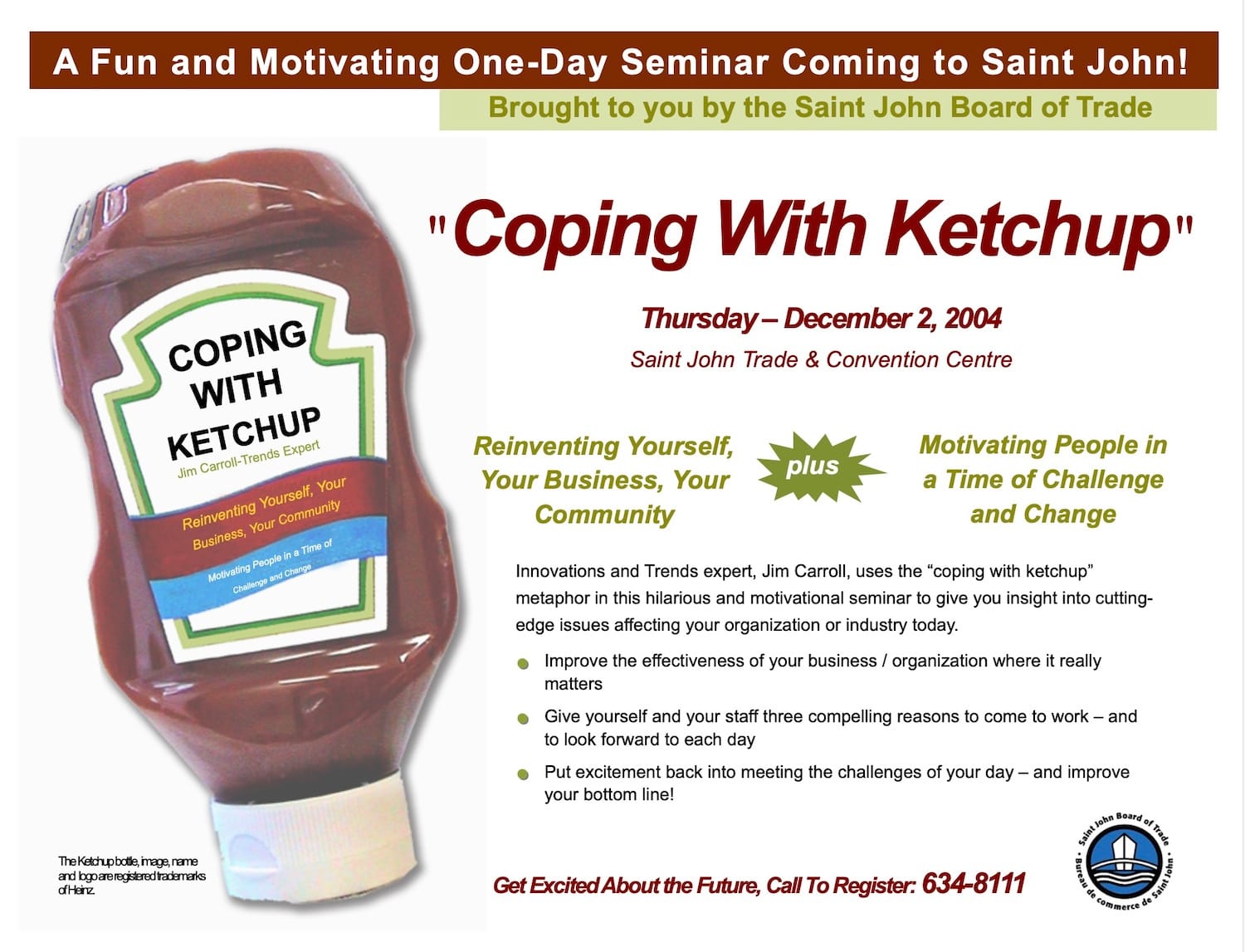"Initiative is a lot like ketchup - it starts out slowly and then happens all at once!" - Futurist Jim Carroll

Here's a story about how, when I stared at a ketchup bottle around 2002, I turned into a $1/2 million revenue stream on the speaking circuit. I don't make this stuff up.
The story has to do with the fact that if you find some initiative with a new and unique idea, run with it - because if you do things right, your tentative first steps will have you running full speed to take advantage of the opportunity! Innovation is like ketchup!
The backstory - in 2001, the dot.com collapse sent everyone into a technology funk - most were convinced that we had seen the end of big, transformative technologies such as the Internet. Magazine and newspaper editors were canceling my regular columns; my speaking topic focused on technology disruption was drying up; I was no longer writing books around the topic. I was in a bit of a funk.
My old future was over, and I had to invent a new one, fast. Around this time, I spoke at the annual conference of the Packaging Machinery Manufacturers Institute - they represent the companies that make the machines that make product packaging. I had decided around this time that I needed to broaden beyond just the technological future and focus on innovation and creativity quite a bit more in my talks. Hence, my keynote revolved around 'innovation and creativity trends in the consumer goods industry.' After all, these were the folks who made the machines that made the packaging in which a lot of food products were being shipped!
Naturally, I began to think hard about the topic and undertake a lot of research for my talk. I found a lot of great stories, such as how StarKist engineered a $200 million revenue uplift by moving away from products in tin cans to resealable plastic pouches. My stage story was a hit - I eventually turned it into an article, 'What's Your Tin Can?'"
Around this time, a new ketchup bottle had found its way into our home - and it was .... different. It was upside down. At one point, I took a picture of my young boys with the product. My mind was intrigued by this simple but brilliant product innovation.

But I also began to notice something - my wife and I would automatically turn the ketchup bottle upside down, while my sons would not. We'd visit friends for dinner or lunch - and notice the same thing. An idea began to form in my mind - many of the stories I was beginning to tell on stage had to do with the struggle with change and adaptation that older members of the workforce had - and that didn't seem to afflict the younger generation.
The older generation was struggling to ... cope ... with .... ketchup.
I told the story on stage a few times as an example of the challenge of generational change in product innovation and the workplace, and the story seemed to resonate. And so at some time or another around 2003, I decided that it was such a wonderful structure for a concept that I launched it as an entire speaking topic. I mean, I was reinventing myself, so why not build a future around ... ketchup? And so was launched the speaking topic, "Coping with Ketchup. How to Adapt to a World of Constant Change."

The keynote story was simple and to the point:
Ketchup?
That’s right—in case you haven’t noticed, Heinz has turned their ketchup bottle upside down, and it is causing havoc in homes around the world. It is part of a revolution in the packaging industry where the “package” has become the brand, and is indicative of a world in which innovation thrives.
But havoc? Yes—Jim has noticed a fascinating tendency in which people unconsciously turn the ketchup bottle the other way ’round. No matter what people do, they can’t seem to deal with this new ketchup bottle.
But it’s mostly adults—kids don’t seem to have the same problem. That’s why Jim Carroll thinks this new ketchup bottle is indicative of the challenges that many people have with change.
What’s going wrong?
Many adults in the workforce today are challenged by the constant changes that are swirling around them.
Rapid, unexplained, relentless and ongoing change results in many different attitudes: resistance; cynicism; fear; suspicion; anxiety; anger; withdrawal; denial. Added to this is the simple reality that many organizations are not very good at helping their people deal with and understand change.
What’s the impact? Projects that go off the rails; budget challenges; missed opportunities; strategic failures; or even worse—mixed messages to customers!
What’s to be done?
The process of transforming the roles of people throughout an organization is complex, and is not easily done. That’s why it is critical that companies take the time to help their people understand how their job, career, company and industry is changing, and what they need to do to turn these changes into opportunities.
That’s the focus of this fast paced, energetic, serious, but fun, presentation by Jim Carroll, delivered either within a keynote presentation or a workshop.
The topic caught a lot of interest - it was unique, it was quirky, and it resonated out on the circuit. It wasn't too long before entire events or keynotes were organized around the idea!

Overall, the entire story turned into a powerful stage metaphor for innovation, change, and the future, and was a critical part of my overall career reinvention. Here's a clip from 2003 where I'm telling the story on stage.
The highlight? In 2003, none other than HJ Heinz invited me in for a talk on the future, trends, innovation, and creativity - and I brought the ketchup bottle story home to its roots!
Overall, I figure the topic was my main innovation story from about 2002 to 2004 as I worked furiously to reinvent. Given that I was charging about $7,500 to $10,000 a keynote at the time, I figured that I easily did 50 to 60 talks around the theme - and hence, generating a total revenue hit of well over $1/2 million of new revenue.
Plus, I successfully reinvented myself.
All because of an upside bottle of ketchup that made its way into our home.
Initiative? It came out of the bottle, and I ran with it!
Coping with Ketchup, by Jim Carroll
Globe & Mail, September 2003
Go on, admit it: You still set the "upside down" ketchup bottle down cap up.
You're not alone. Lots of people -- adults mostly -- automatically turn the bottle so the white cap is at the top -- even though it's been almost a year since Heinz started to offer the new bottle. It's a pretty good example that when change comes about, there are plenty of people who struggle to adapt.
Of course, we can all be forgiven for an inability to cope with ketchup bottle change because it involves instinct and ingrained behavior.
It's when we can't deal with another kind of change -- things that you have to control and adapt to -- that things go wrong.
The problem is, we live in a time that involves a rapid rate of change. Just take a look around. Technology continues to invade our workplaces, resulting in massive changes to day-to-day business processes and procedures. The customers and marketplace have changed, with so much new competition that the idea of "captive consumers" and "guaranteed revenue streams" has gone by the wayside.
New products come and go at an increasing and often infuriating pace as innovation comes to take hold in many organizations. Mergers, breakups, reorganizations, and restructuring result in an almost constant shuffling of job and career responsibilities.
In times like these, you can guarantee yourself that there will be much more new in your life tomorrow than just a different ketchup bottle.
Yet the issue of change continues to be a big problem for organizations because so many people find it difficult -- or simply don't want -- to cope.
The implications are huge: Projects get bogged down or fail. Tension and workplace stress rise. Misguided strategies are introduced and ill-founded rumours fly. All the classic signs of an organization full of people who aren't prepared to cope with change.
If you are dealing with these realities -- either as an individual seeking to enhance your career or as an executive responsible for taking your organization forward -- there are a few ways out:
- Get into the right frame of mind
Years ago, the Pogo comic strip featured a panel in which he observed: "We is faced with insurmountable opportunities." Rather than seeing change as a threat, take a look for the opportunity that might exist within any type of change.
The wrong frame of mind is illustrated in a comment by Ogden Nash: "Progress is great but it has gone on far too long." If that is the way you react to new technologies and new ways of working, then you are almost making it certain that you'll battle progress -- and as soon as you do, you'll be setting yourself back.
- Get rid of your 'not-my' barriers
Many people and corporate cultures react to any type of change, particularly those involving business or workplace processes or corporate structure, by erecting as many barriers as they can.
Immediately, the refrain starts -- it is "not my department / responsibility / job / area of expertise / problem / day!"
Putting up such barriers almost guarantees that you'll let the change get the worst of you. Rather than trying to avoid something, seek to take an active role. That way, you'll guarantee yourself a learning experience, develop new skills and capabilities, and ensure that you take an active and healthy role in helping to ensure that the specific type of change is successful.
- Don't deny change
Accept the inevitability of change. Like it or not, things will be different tomorrow. There's a statistic that is used by Australia's Innovation Council chairman: 65 percent of children in preschool will be employed in roles and jobs that don't exist today.
Believe that, and use it as a barometer for the type of change that is set to occur within every job and career today.
Banish from the workplace is the worst phrase ever to be coined: "We've always done it that way." Well, so what? Maybe that means it's ripe for a change. Why not try something new?
One day, someone at Heinz looked at the same old ketchup bottle they'd been selling for decades, and asked, "Why not turn it upside down?" Can you imagine the reaction -- a likely chorus of naysayers who immediately suggested that it would be impossible, and perhaps downright dumb, to do such a thing? Yet look at the result today -- a practical, sensible new product -- and it is evident that the change was a success.
- Anticipate change
Establish some type of "change radar." You should always be on the lookout for signs of the forthcoming business and industry change that might affect you. Keep your ears and eyes tuned for any signs that could result in a change in your job or career circumstances. If you learn to identify the signs of impending change, then you can begin to determine what you might need to do to enhance your career skills, and any necessary training you might need to take, in addition to gaining insight into some of the new responsibilities and activities that you might be able to undertake.
- Adopt the attitude of kids
The younger generation today seems to have an ingrained ability to cope with change. They see the ketchup bottle, and say "Kewww.!" They're accustomed to change -- because they are growing up in the midst of it. To them, change is normal and to be expected.
Adopt their attitude -- "change is cool" -- by turning every situation of change into an opportunity rather than a threat.
Futurist Jim Carroll has successfully reinvented himself multiple times throughout his career.

